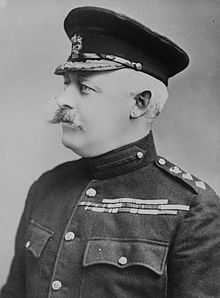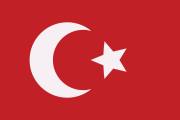James Grierson
| Sir James Grierson | |
|---|---|
 Grierson as a Colonel | |
| Born | 27 January 1859 |
| Died | 17 August 1914 (aged 55) |
| Allegiance |
|
| Service/branch |
|
| Rank | Lieutenant General |
| Unit |
Anglo-Egyptian War Boxer Rebellion Second Boer War World War I |
| Commands held |
1st Division Eastern Command |
| Awards |
Knight Commander of the Order of the Bath Companion of the Order of St Michael and St George Commander of the Royal Victorian Order |
Lieutenant General Sir James Moncrieff Grierson KCB CMG CVO ADC(P) (27 January 1859 – 17 August 1914) was a British soldier.
Military career
Grierson was commissioned into the Royal Artillery in 1877.[1]
He served in the Egyptian War including the actions at Kassassin and Tel el Kebir, as Deputy Assistant Quartermaster General with the Indian contingent in 1882.[1] He was Deputy Assistant Adjutant and Quartermaster General for the Sudan expedition and was involved in actions at Suakin, Hasheen and Tamai in 1885.[1] He was Deputy Assistant Quartermaster General for 2nd Brigade during the Hazara expedition in 1888.[1] He was appointed Deputy Assistant Adjutant General, Intelligence, at Army Headquarters in 1890 and then became Brigade Major for the Royal Artillery at Aldershot from 1895 to 1896 when he became Military Attaché in Berlin[1] acquiring what Sir John French later described as "an intimate knowledge of the German army."[2]
He served in China during the Boxer Rebellion in 1900, and later the same year in the Second Boer War in South Africa. Lt-Col Grierson was in charge of army baggage during Roberts’ march on Bloemfontein.[3]
After returning from the war he became Assistant Quartermaster General for the 2nd Army Corps and Chief Staff Officer to Sir Evelyn Wood, commanding the corps;[4] and was promoted to the substantive rank of Colonel in October 1901.[5] In early 1902 he was ordered for temporary duty in the Remount Department.[6]
Grierson was appointed Director of Military Operations at Army Headquarters in 1904.[1] In January 1906, during the First Moroccan Crisis, Grierson (DMO) was tasked with drawing up detailed plans for deployment of an expeditionary force to Le Havre in the event of war. [7] He and his deputy Robertson organised a “strategic war game” to explore the options, which persuaded them that British intervention was necessary to avoid French defeat. They began talks with the French General Staff and with the French military attaché Colonel Victor Huguet, and that same year Grierson, Robertson and Huguet toured the Charleroi to Namur area. However, little further progress was made until after Wilson became DMO in 1910.[8][9]
Grierson was then appointed General Officer Commanding, 1st Division at Aldershot Command in 1906 and General Officer Commanding-in-Chief for Eastern Command in 1912.[1]
In the Army Manoeuvres of 1912, he made full use of aircraft reconnaissance to decisively beat Douglas Haig, despite Haig having the odds in his favour.
In the Army Manoeuvres of 1913, Grierson acted as Chief of the General Staff (CGS) for Sir John French. Douglas Haig noted in his diary, "Sir John French's instructions for moving along the front of his enemy (then halted on a fortified position) and subsequently attacking the latter's distant flank, were of such an unpractical nature that his Chief of the General Staff demurred. Some slight modifications in the orders were permitted, but Grierson ceased to be his CGS on mobilization, and was very soon transferred to another appointment in the BEF."[10] Even before leaving the field of the manoeuvres (26 September 1913), French told Wilson that he was not satisfied with Grierson’s performance. Murray was appointed chief of staff designate in his place.[11] French himself described Grierson as a "dear old friend and comrade", ..who astonished French soldiers by his knowledge of the history of their regiments and whose "military acquirements were brilliant and in every respect up to date."[2]
Grierson was very overweight, and used to go red in the face from bending over, due to high blood pressure, and Edmonds later claimed that his staff were issued with penknives to bleed him if necessary.[12] He died of an aneurism of the heart on a train, near Amiens at 7:00 a.m. on 17 August 1914. His replacement as commander of II Corps was Sir Horace Smith-Dorrien. Grierson spoke French fluently and was a personal friend of Haig, the commander of I Corps, so it is possible that relations over the next few days, both between the two British corps and with the French, might have been better had he lived.[13]
Grierson's body was repatriated, a practice allowed at that time, and is buried in the Glasgow Necropolis in PRIMUS 38 with his sister, father and mother. These were full interments.[14]
The Sir James Moncrieff Grierson prize for languages was later established at the Royal Military Academy Sandhurst.
Medals and Orders

British decorations
- Companion of the Order of St Michael and St George (CMG) - 1902
- Royal Victorian Order, Commander (CVO) - 1904 (Member MVO 1890s)
- Knight Commander of the Order of the Bath (KCB), 1911 (Companion (CB) 29 November 1900, in recognition of the services during operations in China[15])
- Knight of Grace, Order of St. John of Jerusalem
- Egyptian Medal, 1882, clasps for "Tel el Kebir" and "Suakin 1885"
- North-West Frontier Medal, clasp for "Hazara 1888"
- Jubilee Medal, 1897
- South African War Medal, clasps for "Cape Colony", "Driefontein", "Johannesburg", and "Diamond Hill"
- China War Medal
- Coronation Medal, 1902
- Coronation Medal, 1911
- Aide de Camp General to the King
Foreign decorations
-
 5th Class, Order of the Medjidie, Ottoman Empire
5th Class, Order of the Medjidie, Ottoman Empire -
.svg.png) Khedive's Star, Khedivate of Egypt - 1882
Khedive's Star, Khedivate of Egypt - 1882 -
 1st Class, Order of the Crown, Kingdom of Prussia - 1901 - on the termination of his appointment as Military Attaché at Berlin[16] (he had previously received the 2nd class of the same order)
1st Class, Order of the Crown, Kingdom of Prussia - 1901 - on the termination of his appointment as Military Attaché at Berlin[16] (he had previously received the 2nd class of the same order) -
.svg.png) Albert Order Medal, Kingdom of Saxony - 1911
Albert Order Medal, Kingdom of Saxony - 1911 -
 Knight Grand Cross of the Order of the Crown of Siam, Kingdom of Thailand - 1911
Knight Grand Cross of the Order of the Crown of Siam, Kingdom of Thailand - 1911 -
 King Rama VI's Coronation Medal, Kingdom of Thailand - 1911
King Rama VI's Coronation Medal, Kingdom of Thailand - 1911
Publications by Grierson
- Notes on the Turkish Army Simla 1882 (compiled for the Intelligence Branch, India)
- A Vocabulary of the Arabic Language Roorkee 1882
- The War in Turkomania: Skobeleff's Campaign of 1880-81 Translated from the Russian of Major-General N. I. Grodekov. Simla 1884-85
- The Armed Strength of Russia Two editions: London 1886 and 1892 (compiled for the Intelligence Branch, London)
- The Armed Strength of Japan London 1886 (compiled for the Intelligence Branch, London)
- The Armed Strength of the German Empire Two editions: London 1888 and 1892 (compiled for the Intelligence Branch, London)
- Staff Duties in the Field: With Notes by Lieut.-General H. Brackenbury London 1891
- Handbook of the Military Forces of Russia London 1894 (compiled for the Intelligence Branch, London)
- Umpiring at Field Manoeuvres as practised by various foreign armies (Aldershot Military Society Lectures, No. 51) Aldershot 1894
- Die heere und Flotten der Gegenwart II Gross-Britanien und Irland The British Army. Berlin 1897
- Records of the Scottish Volunteer Force, 1859–1908 Edinburgh and London 1909
- Military Papers and Articles, Translations, Reviews contributed to military journals both British and foreign, and to the daily press.
Family tree
Below is a family history of Sir James Moncrieff Grierson:
George Lyon of Garemount, Dumbartonshire, born 25 August 1793; died 21 February 1872; married at Falkland, 14 June 1825, Jane, daughter of Harry HOPE of Millfield, Fife, and had 9 children:
(issue 3) ALLISON LYON, born 12 February 1829; married, 31 March 1858, GEORGE MONCRIEFF GRIERSON, (Merchant), Glasgow, 2nd son of the (Reverend) JAMES GRIERSON, Doctor of Divinity, (Minister) of Errol, & his wife, MARGARET MONCRIEFF. George died 4 February 1896; issue (3) three sons and six daughters:
- (Lieutenant-General) James Moncrieff Grierson, born 27 January 1859; a large, polished-brass plaque is located in the Glasgow Cathedral, dedicated to his memory,
- (Captain) George Lyon Walker Grierson, of Royal Horse Artillery, born 6 February 1861; educated at Glasgow Academy and Woolwich; entered the Royal Artillery in 1880, served in the Afghanistan War of that year (medal) and in the Bikanir expedition; went to India in 1891 and died of cholera at Lucknow, India, 19 October 1892; a polished-brass plaque is located in the Glasgow Cathedral, dedicated to his memory,
- Jane Hope Grierson, born 2 February 1863
- Margaret Moncrieff Grierson, born 14 March 1865
- ALLISON Mary Grierson, born 23 January 1867; married, 28 April 1897, THOMAS HARVEY, and has issue a son, THOMAS BARNETT HARVEY, born 11 September 1899
- David Alexander Grierson, born 13 December 1869; died 9 January 1870
- Mary Hope Walker Grierson, born 14 June 1871; married 12 June 1895, JOHN TRAIL CARGILL, and has issue a daughter, ALLISON HOPE CARGILL, born 13 August 1896
- Jessie Moncrieff Grierson, born 13 April 1873; died 3 June 1877
- Robina Constance Grierson, born 31 July 1874.[17][18]
Further reading
The Life of Sir James Moncrieff Grierson by D.S. Macdiarmid (London: Constable, 1923)
- Holmes, Richard (2004). The Little Field Marshal: A Life of Sir John French. Weidenfeld & Nicolson. ISBN 0-297-84614-0.
- Jeffery, Keith (2006). Field Marshal Sir Henry Wilson: A Political Soldier. Oxford University Press. ISBN 978-0-19-820358-2.Harper
- Terraine, John (1960). Mons, The Retreat to Victory. Wordsworth Military Library, London. ISBN 1-84022-240-9.
- Travers, Tim (1987). The Killing Ground. Allen & Unwin. ISBN 0-85052-964-6.
- Tuchman, Barbara (1962). August 1914. Constable & Co. ISBN 978-0-333-30516-4.
References
- ↑ 1.0 1.1 1.2 1.3 1.4 1.5 1.6 Liddell Hart Centre for Military Archives
- ↑ 2.0 2.1 Sir John French (1919). 1914. London: Constable & Co. p. 37.
- ↑ Holmes 2004, p99
- ↑ "Naval & Military intelligence" The Times (London). Monday, 23 December 1901. (36645), p. 8.
- ↑ The London Gazette: no. 27387. p. 8840. 13 December 1901.
- ↑ "Naval & Military intelligence" The Times (London). Friday, 28 February 1902. (36703), p. 5.
- ↑ Holmes 2004, p139-41
- ↑ Jeffery 2006, p85-6
- ↑ Tuchman 1962, p55-6
- ↑ Warner, Philip Field-Marshal Earl Haig (London: Bodley Head, 1991; Cassell, 2001) pp110–111
- ↑ Holmes 2004, p149-50
- ↑ Travers 1987, p14
- ↑ Terraine 1960, p50-1
- ↑ CWGC record
- ↑ The London Gazette: no. 27385. p. 8715. 10 December 1901.
- ↑ The London Gazette: no. 27393. p. 1. 3 January 1902.
- ↑ David Alan Grierson (aka Lyon) RootsWeb: GRIERSON-L Compilations on Lyon, Walker,Grierson families of Scotland
- ↑ RootsWeb: GRIERSON-L David Alan Grierson (aka Lyon), & others
External links
| Wikisource has original works written by or about: James Moncrieff Grierson |
- Centre for First World War Studies
- Liddell Hart Centre for Military Archives
- The Army Navy Air Force site has a copyrighted photograph (you will need to scroll down to see it.)
- University of Glasgow Manuscripts Catalogue
- Glasgow Cathedral Picture Tour
| Military offices | ||
|---|---|---|
| Preceded by Arthur Paget |
General Officer Commanding the 1st Division 1906 – 1910 |
Succeeded by Samuel Lomax |
| Preceded by Sir Arthur Paget |
GOC-in-C Eastern Command 1912–1914 |
Succeeded by Sir Charles Woollcombe |
| Preceded by New Post |
GOC II Corps August 1914 |
Succeeded by Horace Smith-Dorrien |
|